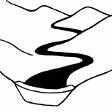

A masonry micro-dam is a structure built of dressed stone pointed with cement mortar. The width of the crest is 0.75 metres. The length generally ranges from 100 to 200 metres depending on the site. The height varies between two and four metres. The dam creates a water reservoir upstream covering an area of around 5 to 15 hectares. Micro-dams are equipped with buttresses and a stilling basin. Each dam has a sluice fitted with a stoplog gate for draining away sediment during the first rains of the season and to regulate water levels. The use of stoplog gates is recommended instead of sluice gates, as the latter are more technically sophisticated and require more maintenance. Farming is carried out upstream and downstream in the rainy season and off-season.
The dam increases the amount of available surface water during the rainy season and groundwater during the off-season. This results in increasing the farmland area as well as yields and production. A second growing season is made possible. Its effect on the water table depends on the depth of the scheme’s foundations: the deeper the foundations, the greater the recharge of ground water. During the rainy season, the lands are used for rice growing. The wells used for irrigating market gardens are fed from the water table, meaning vegetables can be grown off-season. The water is also used for watering livestock, fish farming and, sometimes, domestic purposes.
Implementation steps: An information and awareness-raising workshop is organised on the IPRO-DB approach at the commune level, involving the villages affected by the project. A general meeting is held to secure the support of the whole village for the development request. The village chief and commune mayor sign off the request. The project team carries out a scoping study and socio-economic surveys. If the outcomes of the scoping study phase and socio-economic surveys are positive, the terms of reference are drawn up for working with consultancies. Consultancies are selected through tender processes to carry out the technical studies and create the invitation to tender document. The project team monitors the consultancies’ delivery of the technical studies. The village pays its financial contribution towards the project. The management committee is set up and organisational and technical training is provided to beneficiaries. Exchange visits are organised with villages that have experience in installing these schemes. The project team, village, mayor and company sign the memorandum of understanding. Stone breaking gets underway. Landowners sign the transfer deeds for the site. The invitation to tender for the building works is published and the contractor selected. The invitation to tender for works supervision is published and the supervisory consultancy selected. The building contractor and supervisory consultancy are introduced to the village and begin the building work. Local labour is employed in building the scheme. Partial acceptance of the building works (for example, foundations, wall, buttresses, stilling basin, gabion reinforcements, etc.) is granted. The project team monitors the building works. Payment for activities is made on a unit-price basis. Interim acceptance is granted. Final acceptance is granted after one year.
A management committee takes charge of opening and closing stoplog gates, organises the maintenance of the scheme and institutes additional measures to protect the scheme (gabions, stone bunds, etc.). It collects and manages maintenance fees, ensures the committee’s rules of procedure are adhered to and organises meetings of local producers. With minimum levels of maintenance, a scheme will remain functional for at least 20 years.
Around 60 masonry dams have been built or rehabilitated in the Bandiagara and Bélédougou areas.
الموقع: Bandiagara and Bélédougou area, Mali, مالي
عدد مواقع تنفيذ التقنيةالتي تم تحليلها:
انتشار التقنية: منتشرة بالتساوي على مساحة (approx. 10-1 كم2)
في منطقة محمية بشكل دائم؟:
تاريخ التنفيذ: منذ 10-50 سنة
نوع التقديم






| تحديد المدخلات | الوحدة | الكمية | التكاليف لكل وحدة (CFA Franc) | إجمالي التكاليف لكل مدخل (CFA Franc) | % من التكاليف التي يتحملها مستخدمو الأراضي |
| غير ذلك | |||||
| total construction | 1,0 | 273817,0 | 273817,0 | 100,0 | |
| إجمالي تكاليف إنشاء التقنية | 273'817.0 | ||||
| إجمالي تكاليف إنشاء التقنية بالدولار الأمريكي | 529.63 | ||||
Better levels of production increase producers’ incomes and improve living conditions.